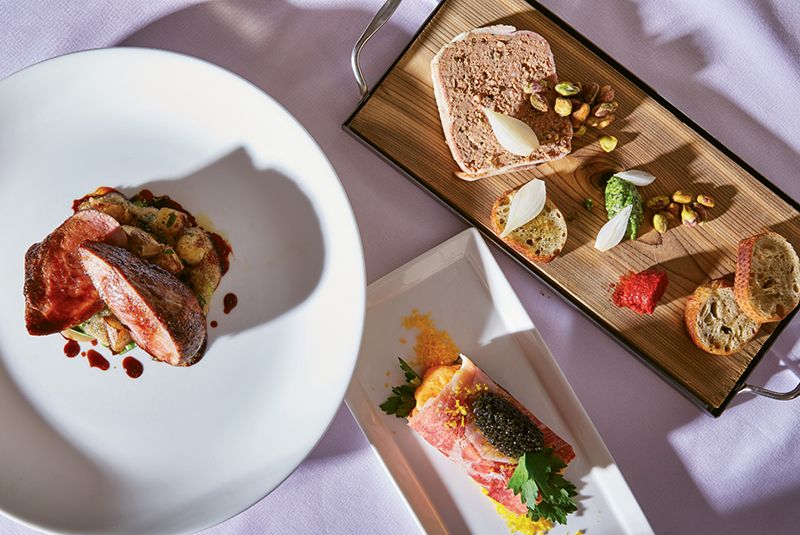Circa 1886’s menu tours the historical eras instrumental to Southern culinary identity

(Left to right) Broken Arrow Axis venison, inspired by Native American cooking techniques and ingredients; a modern take on the Southern grilled cheese; a nod to Europe with veal pâté.
Think Lowcountry food—what comes to mind? Rice, shrimp, oysters, and Huguenot torte, yes. But how about preserved rabbit with bear tallow, lump crab and tobacco onions in sherry mornay, squash cake topped in juniper ash, or soursop and apple salad with hominy crunch? At Circa 1886, dishes familiar and new appear on executive chef Marc Collins’s re-envisioned menu, which features flavors, ingredients, and traditions integral to South Carolina foodways, channeled through a modern lens. Divided into four categories—Tastes of Native Tribes, Flavors Brought from Africa, Influences from Europe, and South Carolina Today—the menu, launched in the spring, celebrates the history, preparation, and cooking methods foundational to the coastal South’s culinary identity.
Over the 18 years he has helmed the kitchen at the iconic Wentworth Mansion in Harleston Village, Collins has aimed to provide the city a refined, “quintessential Southern restaurant.” But these days, the chef is telling a more comprehensive account of the region’s past beyond shrimp and grits. “I wanted to make South Carolina’s history more personal [for diners],” says Collins, “by looking at these significant eras that have influenced Southern food today.”
To accomplish such an elaborate endeavor, he worked with scholars and chef peers alike. For insight into Native American agricultural practices, particularly the role of indigenous grains, Collins spoke with culinary historian Dr. David Shields of the Carolina Gold Rice Foundation. According to Shields, tribes such as the Catawba, Kiawah, and Edisto—who thrived here long before the arrival of the Europeans who displaced them—lived off the land and subsisted on wild rice and other whole grains. Since wheat flour was a Western import, the courses in the “Tastes of Native Tribes” section of the menu are, by coincidence, gluten-free.

(Left) Chef Marc Collins; (right) Kunan aya (tigernut) milk tart from “Flavors Brought from Africa”
To locate a local wild rice source, Collins enlisted the help and expertise of Glenn Roberts of Anson Mills. The search revealed the many difficulties inherent to recreating literal interpretations of the past. “Putting together a themed menu is a joy,” Collins explains. “But finding ‘authentically’ Lowcountry ingredients is where things got tricky.” In the end, he ordered his rice, along with specialty products such as bear tallow and venison, from further afield.
Collins also sought guidance from local chef and academic Kevin Mitchell—who has researched and documented the essential, yet often overlooked, role of black chefs in the history of Southern food—as well Gullah chef BJ Dennis, whose travels to West Africa, Trinidad, St. Croix, and the Virgin Islands have helped provide further insight into the African diaspora’s pivotal contributions to Lowcountry cooking. Dennis shared with Collins preparations such as pepperpot, made of spiced and stewed meat (one of Guyana’s national dishes to this day). Collins pays homage by braising his Piedmontese oxtail in what he calls “pepper pot liquor,” completing the dish with conch fritters, young sweet potatoes, mustard greens, and pickled okra.
Collins contributed his own extensive knowledge of classical European cooking and contemporary Southern food research to flesh out the rest. However, in the spirit of creative license, there are several purposeful historical exceptions that appear throughout the menu. While preserving rabbit with early drying techniques may have proven the more loyal interpretation, “I didn’t want to serve jerky,” Collins says. “You have to take things to a level people are willing to experience in a restaurant setting.” So he confits the protein instead. The dish, a starter, appears as a tender rillette accompanied by Seewee bean succotash and corncob bouillon sprinkled with powdered bear tallow (a natural fat still widely used today).
A visit to Circa 1886 is then as much a lavish meal as a meditative journey. Perhaps in showcasing the diverse origins of Lowcountry cuisine, and by acknowledging the vital culinary influence of cultures otherwise too often obscured, Collins has at last achieved his goal: furnishing Charleston with its “quintessential Southern restaurant.”